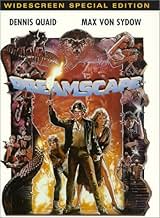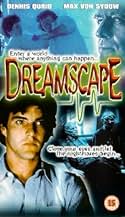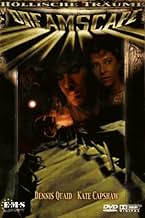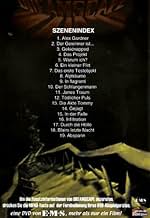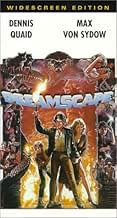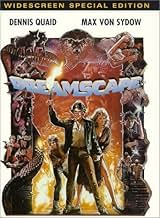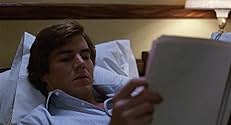Un hombre que puede manipular los sueños de la gente es reclutado por una agencia gubernamental para ayudar a curar al presidente de los Estados Unidos de sus pesadillas sobre la guerra nucl... Leer todoUn hombre que puede manipular los sueños de la gente es reclutado por una agencia gubernamental para ayudar a curar al presidente de los Estados Unidos de sus pesadillas sobre la guerra nuclear, pero tropieza con un plan de asesinato.Un hombre que puede manipular los sueños de la gente es reclutado por una agencia gubernamental para ayudar a curar al presidente de los Estados Unidos de sus pesadillas sobre la guerra nuclear, pero tropieza con un plan de asesinato.
- Dirección
- Guionistas
- Elenco
- Premios
- 1 premio ganado y 2 nominaciones en total
Opiniones destacadas
Dennis Quaid, at the peak of his charisma, plays Alex Gardner, a psychically gifted young man who would rather use his gifts for self- gain but reluctantly agrees to help old pal Paul Novotny (ever delightful Max von Sydow) who's developed a revolutionary dream therapy program. It seems that now people like Alex can be inserted into the nightmares of others, and help them to deal with them. However, there's a smooth but cold government man (a chilling Christopher Plummer) who has sinister motives for supporting this program.
Wonderful visual design is just one of the hooks of this story; the nightmares each get their own "dream tunnel", for one thing, and for another, the bleak post-apocalyptic landscape of which the President (Eddie Albert) dreams and the skewed images experienced by young Buddy (Cory "Bumper" Yothers) are very well realized. The special effects are eye popping, and things do get pretty grim and gory (a heart is ripped out of a chest). One of the highlights of the movie is the nefarious Snakeman, a monster brought to life through a combination of stop motion and an actor (Larry Cedar) in a costume. The music is cheesy electronic stuff, which is kind of surprising considering that the composer is the great Maurice Jarre. There's some witty dialogue, and a steamy subplot involving Alex and the young Dr. Jane DeVries (Kate Capshaw, who's lovely but sporting some real 80s hair here).
The cast couldn't be better; also appearing are the eternally amusing David Patrick Kelly as weaselly little psychopath Tommy Ray, George Wendt as a horror novelist who snoops around, and character actors such as Redmond Gleeson, Peter Jason, Chris Mulkey, Madison Mason, and Brian Libby. Also, Ruben keeps the pacing consistent and the big showdown between Alex and Tommy Ray is a set piece worth waiting for.
With all of this going for it, "Dreamscape" is a totally engrossing diversion that may be very much of its time but still does a good job of entertaining the viewer.
Eight out of 10.
Dreamscape may be a good candidate for "most misleading poster art". The theatrical poster, which is also the DVD cover, suggests a kid-oriented, slightly hokey adventure film--perhaps a combination of Indiana Jones and the Temple of Doom (1984), The Neverending Story (1984) and "The Hardy Boys Mysteries" (1977). Not that the combination sounds like a bad idea to me, but this film is much more adult, much more sci-fi, and more of a thriller. It's not really an adventure, although some of the dream material could be seen that way. The tone, if not content, is closer to something like Coma (1978), and later films like Flatliners (1990) and The Cell (2000), the latter being obviously influenced by Dreamscape. It also has a bit of the bizarre surrealist tone of late-1970s fare such as Phantasm (1979) (and this aspect also influenced films like The Cell).
Part of the reason the films works as well as it does is the cast. Dennis Quaid carries the film, frequently injecting enjoyable comic relief. Max von Sydow is always excellent. Kate Capshaw, as Jane DeVries, is also good as the research assistant and Alex' love interest. Although they're underused, Christopher Plummer, Eddie Albert, George Wendt and David Patrick Kelly all turn in superb performances as well.
Director Joseph Ruben frequently treats us to great dream sequences, with often-subtle touches. Note, for example, the different colors upon entering different persons' dreams. For the relatively benign construction worker, the entry is blue. For the child troubled with nightmares, there is a complex of colors. For Jane, who is giving Alex the cold shoulder, the color is an icy silver-white. Although the film was relatively low budget, and effects relatively primitive at the time, I thought all of the effects worked well. I even loved the part stop-motion, part guy-in-a-costume snake-man. At times the stop motion work briefly resembled Harryhausen. I especially loved the more surreal and more horrific aspects of the dreamworlds, such as we see from Eddie Albert's character, the expressionistic sets for the child's dream, the zombies, and so on.
Surprisingly, perhaps, Dreamscape is also much more effective on the suspense/thriller end than I expected it to be. There are a few great chase scenes, and one brutal (though not graphic) murder on-screen, one off-screen. It was also steamier than I expected in one section.
I enjoyed watching this but realized, after it was over, that it didn't make a whole lot of sense and there were plot holes left and right. Still, it moves quickly and the dream sequences themselves were lots of fun. This was also the second PG-13 rating ever released. It was cut to get that (a sex scene between Quaid and Kate Capshaw was almost completely dropped) but there were some complaints about the amount of violence (none of which was cut) that was allowed in. By today's standards though it's not that bad.
Quaid is good--he's young, handsome and not taking any of this seriously. Max von Sydow is very good as the head doctor of the research. Kate Capshaw is pretty terrible as his assistant. Christopher Plummer seems to be proving he can say his lines without moving a muscle in his face. Albert is lots of fun as the President and David Patrick Kelly almost runs away with the movie as Tommy Ray Glatin.
So a quick, fun little movie. Just don't think about it too much.
¿Sabías que…?
- TriviaWas the second film to be Rated PG-13 under then new MPAA ratings guidelines following Jóvenes defensores (1984), which had come out weeks prior to this film's release.
- ErroresBlair may be the head of the CIA but he is not in charge of security for the President, that falls solely on the Secret Service. Blair and Novotny would have no say in the matter of where the President would be staying.
- Citas
Alex Gardner: [14:53] Nice place you got here. Who's your decorator? Darth Vader?
- Versiones alternativasWhen reclassified by the BBFC in 2000 the nunchaku weapon was no longer deemed a problem to pass on film following a weapons rethink in 1999. The BBFC waived the 28 seconds of cuts made to previous versions. Dreamscape was cut for the UK cinema upon original release in 1984 and video issues also suffered the same edits. The scene on the train where Alex meets Tommy is shorter as it features the infamous nunchaku, which rarely made it onto the British Screen at this time, and shots of a man's severed heart were also removed by the UK censor. This scene can be seen in the TV version which was shown on BBC1 albeit minus a few "strong" words. When the BBFC reclassified the film in 2000 under newer guidelines the nunchaku was no longer a problem and they waived the aforementioned cuts.
- Bandas sonorasBaby, Can't We Take It Home
Composed and Produced by Craig Huxley (as Craig Hundley)
Selecciones populares
- How long is Dreamscape?Con tecnología de Alexa
Detalles
Taquilla
- Total en EE. UU. y Canadá
- USD 12,145,169
- Fin de semana de estreno en EE. UU. y Canadá
- USD 2,257,627
- 19 ago 1984
- Total a nivel mundial
- USD 12,145,169
- Tiempo de ejecución1 hora 39 minutos
- Color
- Mezcla de sonido
- Relación de aspecto
- 1.85 : 1






